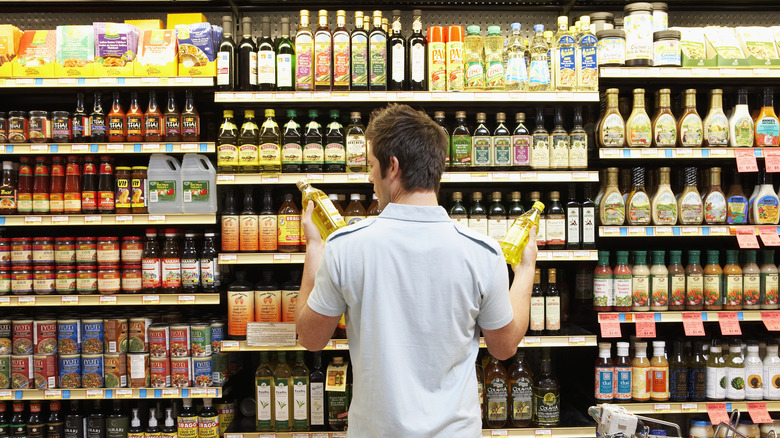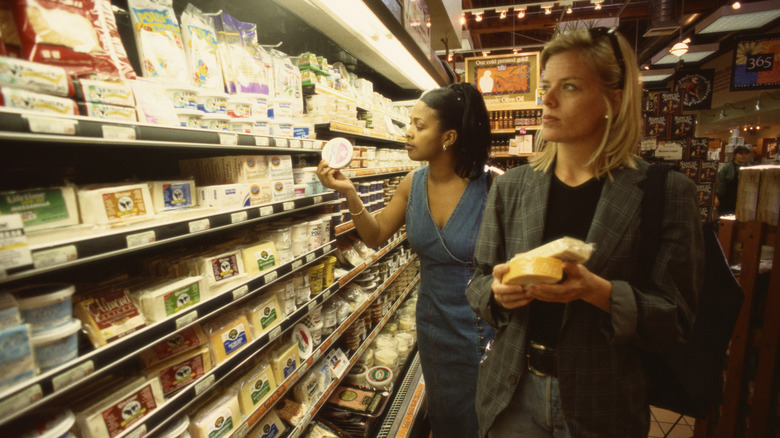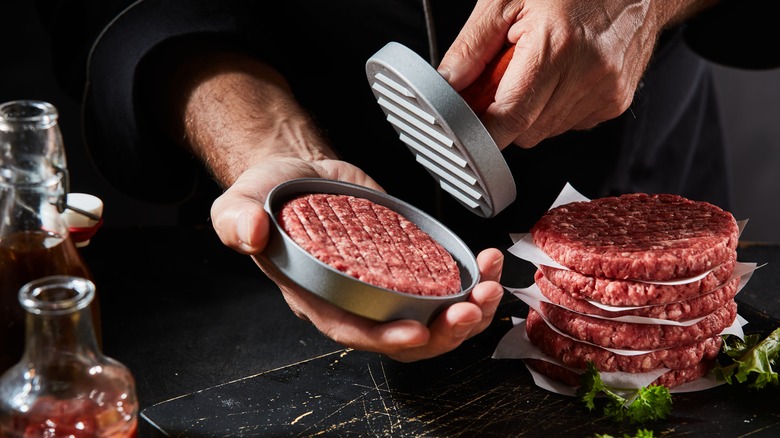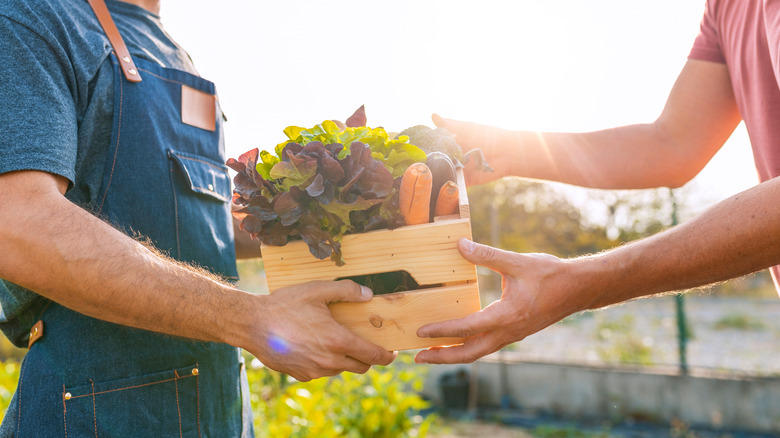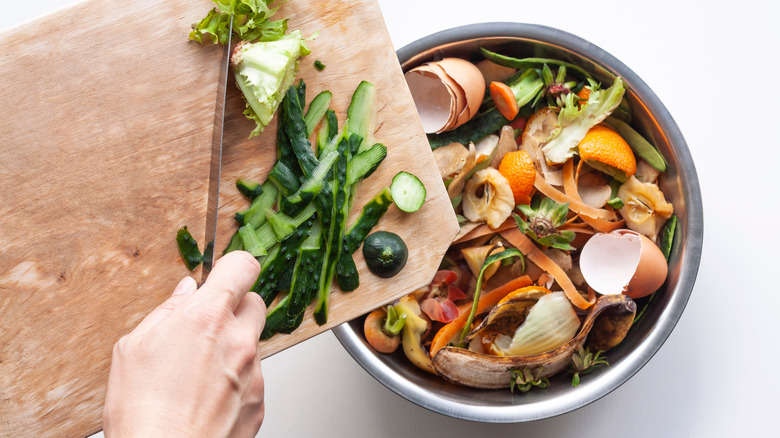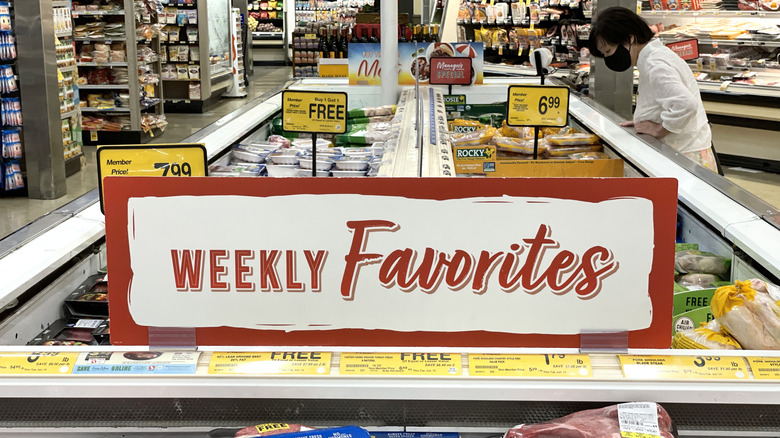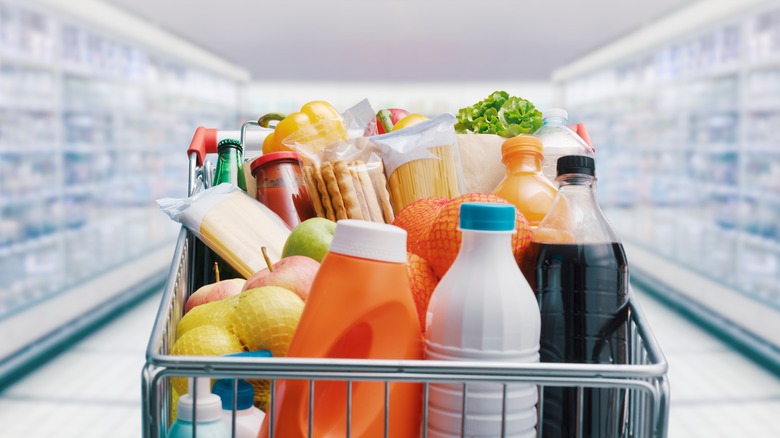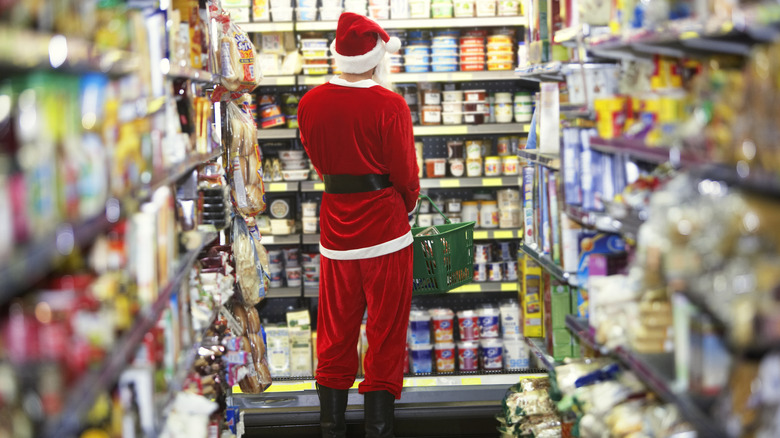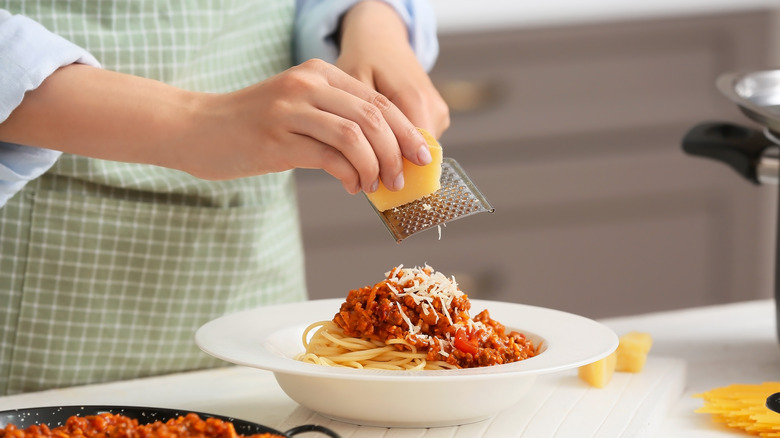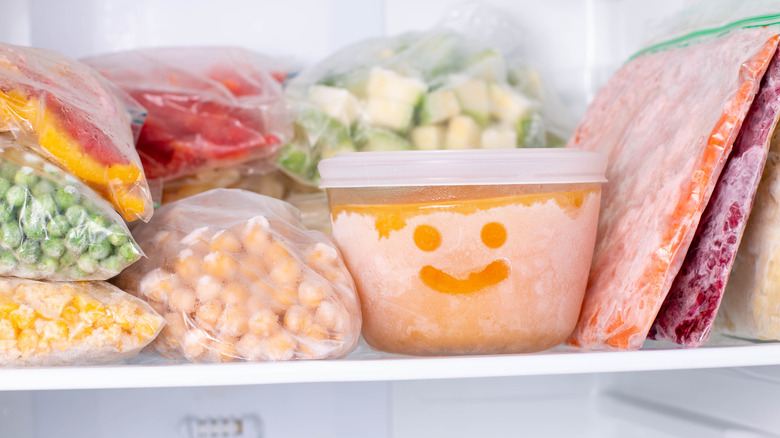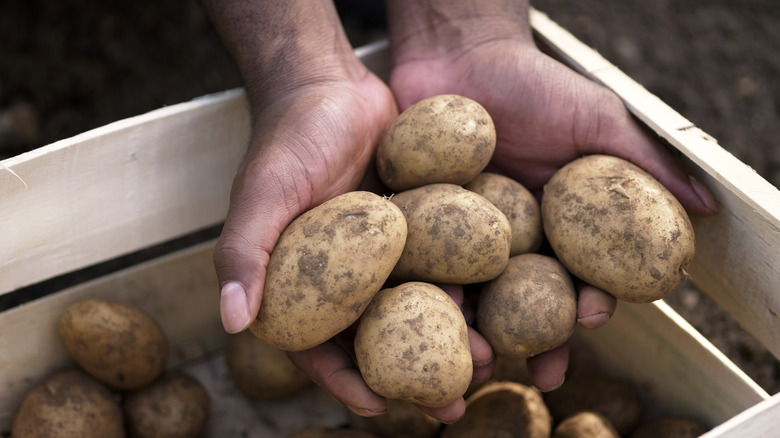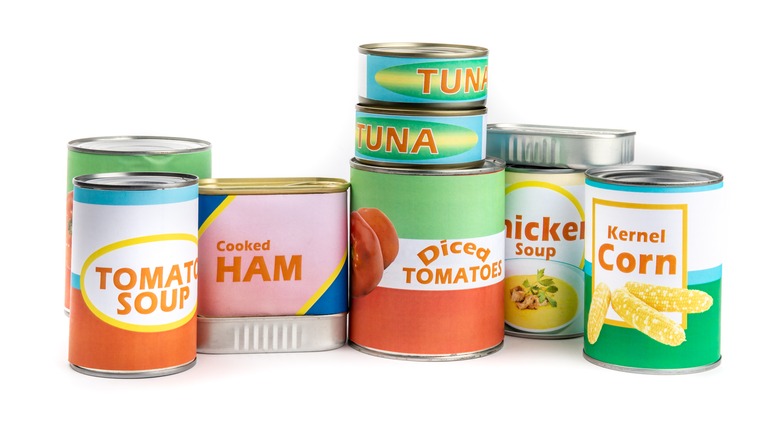13 Ways To Help Save Money At The Grocery Store
We may receive a commission on purchases made from links.
Saving money on groceries is more important than ever. The price of food is set to increase by 7.9% in 2023. At the same time, many people have less money to spend on groceries overall, as emergency government assistance set up during the pandemic comes to an end. Some households are seeing their Supplemental Nutrition Assistance Program (SNAP) benefits reduced by more than $250 per month, via NPR.
However much you're currently spending on groceries, it might be more than you have to. Eating out less and cooking at home more is one way to reduce your food spending, but grocery shopping isn't automatically your most cost-effective option. Being mindful of the best-possible values and deals when shopping for food can help you make major savings. Whatever your budget or location, here are some tips to keep in mind to bring down your spending next time you're at the grocery store.
Buy marked-down items
Marked-down items at grocery stores may be closer to their expiration date than full-price items, but this is not always the case. Sometimes, stores lower the price of a given item just to make it sell faster and open up shelf space. Stores like Whole Foods Market that slice and package their own cheese often have a "bad cut cheese bin," a separate area where irregular pieces of cheese are sold at a discount. Resulting of cheesemongers breaking down large wheels of cheese, these off-cuts might be too small or have too much rind on them to be sold at the regular price. So-called "bad cuts" are a cost-effective way of trying out a type of cheese before committing to a larger piece, or buying smaller quantities of good-quality cheese if you aren't going to use a lot. Even a piece with a lot of rind might be worth buying, as you can use the cheese rind from Parmesan and some other hard cheeses to add delicious flavor to a soup, broth, or homemade tomato sauce.
Some stores will also offer "irregular" produce at a discount: misshapen, lumpy fruits or vegetables that still taste just as good as the more visually-appealing ones in the produce aisle.
Stretch your proteins
Meat is one item that can quickly add a lot to your grocery bill, so it may be cost-effective to stretch your meat or other protein as much as possible. Recipes containing meat can be bulked up with pasta, rice, beans, potatoes, or other vegetables, or by making them into a soup or stew; the water content of these dishes helps to make them more filling and thus able to last longer and serve more people. In recipes that use patties of ground meat, like meatloaf, meatballs, or burgers, you can mix the meat with extenders like lentils, breadcrumbs, bulgur wheat, or oats.
Oats can help you save money on ground beef when mixed in at a ratio of ½ to 1 cup of oats per serving of meat. Once the meat is cooked, the oats will meld into the final product and be scarcely noticeable. Dried oats themselves are an excellent economy food, being nutritious and mild enough in flavor to accept a wide range of seasonings, with a shelf-life of up to two years.
Buy in bulk, but only what you need
Wholesale retailers like Costco and BJ's attract people with discounts on bulk items, but buying in bulk isn't always the deal it seems. Buying in bulk can be a way to save money on groceries, but it can also turn out to be more expensive in the long run if you're letting some of what you buy go to waste. Overpacking your fridge with too much stuff can actually cause food to spoil faster because the cold air inside the fridge doesn't have room to circulate. The UN's advice for minimizing food waste includes encouraging shoppers to "shop smart," meaning to plan your shopping ahead and only buy what you know you're going to use.
Whether to buy a given item in bulk depends on the needs of your household as well as the item's shelf-life. For example, mixed salad greens don't last long, so it only makes sense to buy in bulk if your household is going to consume them within a few days. Meat can be frozen, so it's easy to portion out into separate meals and freeze what you aren't using immediately. Buying meat in bulk can also be cheaper than buying it pre-cut. You can get serious savings on steak — up to $3 a pound — by purchasing a whole roast instead of precut steaks, which has the additional benefit of allowing you to determine exactly how you want your steak to be cut.
Buy seasonal, local produce when possible
Depending on where you live, you may wish to consider shopping for fruits and vegetables at farmer's markets or signing up for a CSA (which stands for "community-supported agriculture"). Not only will you be supporting local farmers by doing this, but farmer's markets may also offer fresh, high-quality ingredients at lower prices than the supermarket. But what if you don't have access to a farmer's market or CSA? You can still save money at the grocery store by skipping the produce aisle, especially avoiding what's not in season. In-season produce is cheaper because it's more widely available locally instead of having to be imported. A guide like this spring vegetable and fruit guide can help you figure out what's in season in your area.
And when it comes to produce, don't automatically assume that fresh is best. In addition to being cheaper and lasting longer, frozen produce may actually be tastier and better for you than out-of-season fresh produce, because it's preserved at the peak of its ripeness and nutritional value. This is also true of some canned products.
Use your scraps
Minimizing your food waste at home is good for the environment, but it's also good for your grocery budget to use up your vegetable scraps and other leftover bits from cooking. Instead of buying vegetable broth, reserve vegetable scraps in the freezer and boil them to make your own. Even the papery skins of onions and garlic can be used in this way. Animal bones and the shells of crabs and shrimp can also be frozen and reserved to make a delicious base for soups and stocks. Instead of throwing out stale bread, you can blend it into sauces as a thickener or crush it up into homemade breadcrumbs. Making base ingredients like this also allows you to control the level of salt and other seasonings that goes in them to your liking.
If you have plants, whether indoors or outdoors, composting is another way to make use of your organic cooking scraps. Scraps reserved in an airtight container on the counter or in the freezer can be blended with water to make a nutritious treat for your plants. And some vegetable scraps can even be regrown at home, with nothing more than sunlight and a glass of water.
Find deals with apps
There are numerous apps designed to help improve your grocery shopping experience. Some stores have their own specific app that shows the latest discounts and sales or provides special deals or coupons to users. As making (and sticking to) a specific shopping list is another way to save at the grocery store, you may also wish to use an app like Flipp or Grocery King that allows you to make and share lists of items and check them off as you go. Some of these even allow you to compare prices across stores within the app. You can do research to find the best app for you based on the stores in your area.
Then there are apps designed to minimize food waste. Too Good to Go allows you to purchase unsold food from vendors that would get thrown away otherwise, like day-old baked goods or pizza, at a discount. Although your options are limited to whatever is available, this can be an excellent way of getting a large portion of food cheaply.
Avoid unnecessary items
Are you buying exactly what you need at the grocery store? Avoiding unnecessary purchases can significantly lower your grocery bill. Check your kitchen carefully and make a list before leaving the house so that you know what items you need to replace. Try not to shop when you're hungry to avoid impulse buys. You can also keep track of your spending before you reach the checkout counter by keeping a tally of the price of your items, whether mentally or using your phone calculator.
As you shop, round up the price of each item to the next even number. This can lead you to put back something you don't really need once you visualize its impact on the total grocery bill. And because you've been rounding up, you'll be pleasantly surprised when you get to the checkout counter and find that your total is actually less than the number you've been counting.
Know when to shop
Knowing the right time to shop can help you get access to the best deals. Weekday shopping is less crowded in general than on weekends, and on Wednesdays, many stores restock for the week and mark down items that were not sold in the previous week. This makes Wednesday a particularly good day to do your grocery shopping. As always, when it comes to marked-down items, check expiration dates and try to only purchase what you will consume within that timeframe.
Around holidays, you'll find access to special seasonal discounts. Stores may have sales before a holiday to open up shelf space for holiday-specific items like Valentine's Day chocolates or Thanksgiving stuffing; any of these same items left over after the holiday will be marked down as stores seek to get rid of them. And leading up to Thanksgiving and Christmas, many food items go on sale that are either seasonal, like olives, or targeted specifically for large home gatherings, such as dips, baking mixes, and jarred pasta sauce.
Avoid prepped ingredients
Just as you'll save by buying a whole roast instead of pre-cut steaks, you should generally avoid pre-cut ingredients when looking to save at the grocery store. You'll have to do a bit of extra work, but the price difference can be staggering between whole versus peeled and chopped vegetables and fruits. This applies to meats, fish, and shellfish as well, which are often more affordable when sold with the skin and bones. As aforementioned, you can make use of the leftover scraps from breaking down your own ingredients. Bones and vegetable peels can be used to make broth, while fat can be rendered from chicken or other animal skin and used as cooking grease.
Another item that is better to buy in its pre-cut form is cheese. A whole block of cheese yields more than a package of pre-shredded cheese of the same weight. Solid cheese stays fresher for longer since you only need to grate as much as you need at one time. In addition, pre-grated cheese contains starch and preservatives designed to prevent the pieces from clumping together, which means that the cheese doesn't melt as smoothly and evenly as freshly-grated cheese.
Make and freeze large-batch meals
When shopping on a budget, it's important to know how much of an ingredient your household will consume in a given timeframe. Cooking ready-made meals and dividing them into portions will help you know exactly how far your ingredients will go. Set aside a day on the weekend to make one large batch of a recipe, or two medium ones for extra variety. Freeze portions of the food separately in individual containers. Not only will this help you track portions, but it will also allow you to thaw out only as much as you need at one time, as frozen food should not be refrozen after being thawed. Frozen meals like this will keep for up to two months in the freezer, and for best results should be thawed slowly in the fridge overnight.
Especially if you have limited space in your freezer, you may wish to consider traditional methods of food preservation that don't require freezing, such as canning, pickling, or making fruit preserves. Even meat can be canned at home and kept out of the refrigerator without spoiling, although you need special equipment to do it safely (a pressure canner that reaches over 240 degrees Fahrenheit).
Buy less meat and more potatoes
Meat is one of the items that can add a lot to your grocery bill quickly. As mentioned above, you can save on meat by buying in bulk, buying meat that hasn't been broken down (for example, whole chicken or pieces with the bones and skin instead of boneless, skinless pieces), and by stretching ground meat with other ingredients. You should also try to purchase meat when it's on sale. Don't shy away from cheaper, tougher cuts like pork shoulder; these work well in a slow cooker or pressure cooker, or you can cook them until tender in an oven if you have the time.
Another way to save is by purchasing less meat altogether. Instead, seek out vegetarian food items to replace or bulk up meat dishes that are nutritionally dense and filling, such as potatoes, beans, lentils, chickpeas, rice and other whole grains, and pasta. In addition to their cost-effectiveness, foods like these have a very long shelf-life and often don't require refrigeration, saving more space in your fridge and freezer. You can prepare them in numerous different ways to add variety to your meals. Eggs are another protein option that's cheaper (and healthier) than meat, and they're not just a breakfast food: Add them to noodles or rice, or consider an egg-based dinner like quiche or frittata.
Compare deals across stores and brands
When grocery shopping, it's always best to compare prices from one store to another, which you can also do with some grocery apps. You may find it economical to split your shopping between more than one store, especially if one of your preferred stores generally carries higher-end items; for example, one store might be best for vegetables and fruits and another for pre-packaged items. And you can, and should, also do price comparisons within the same store.
Generic or store-brand items are often much cheaper than name-brand and may taste just as good. When you browse a grocery store's shelves for these more affordable brands, make sure you are looking up and down, and not just in front of you. Grocery stores place the most expensive and eye-catching products at the eye level of shoppers to encourage them to buy, while the cheaper equivalents can be found either at the very top or bottom of the shelf.
Join a loyalty program
Many grocery stores offer free-to-join loyalty programs that allow shoppers to enjoy members-only discounts. These programs allow stores to collect data on the purchasing habits of their most frequent customers, which informs decisions like pricing, inventory, and promotions. Loyalty program discounts are automatically deducted at checkout, eliminating the need for coupons, but if you do use coupons, you can further add to your loyalty savings. In some stores, loyalty and coupon discounts can be accessed digitally using your phone.
If you're wondering if grocery store loyalty programs are worth it, the answer depends on your spending habits. Grocery store loyalty programs reward shoppers for going to the same store, but you should still do research to determine which is the best option for your grocery shopping needs. As with any of the suggestions on this list, the right saving techniques for you and your household may vary, and you may find that a combination of strategies and tips works best to get you the biggest savings on food shopping.
